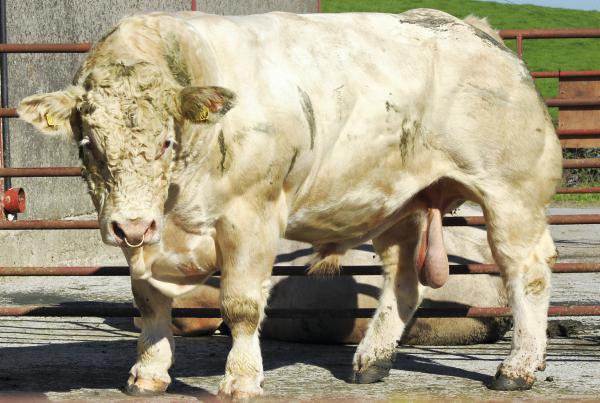A stock bull plays a vital role in a suckler herd. Without a fertile bull that is fit for purpose, cows would struggle to go back in-calf. Without calves on the ground, a suckler herd is not profitable regardless of how strong the mart trade or finishing prices.
There is a saying that the bull is half the herd. In fact he is much more than this. Take a suckler herd of 40 cows – each cow is responsible for producing her own calf. If there is one poor-quality cow producing a plain calf, then there are still 39 good cows producing good calves.
But compare this to the bull. If the stock bull is not a good breeding animal producing quality calves, then he will produce 40 plain or average-quality calves. The chances are that the herd owner may think the calves will grow out and put on flesh by the end of the grazing season.
If so, the bull will have served cows for a second year before you have made the decision to cull him, meaning that there will be another 40 plain calves next year. When purchasing a bull, using the €-star data for a bull will help to eliminate the chances of buying a bull that will breed inferior calves. Select the bull based on the stars that match the type of animal you are looking to produce.
For replacements, select on maternal index but also focus on daughter’s milk and calving data for both the bull and the heifers he is likely to produce. For store or finishing cattle, then terminal index and carcase data is relevant. Again, calving data is important as dead calves are worth nothing no matter how big or how well shaped the calf is.
Like any tractor that requires servicing before undertaking a major piece of work, you should be thinking of giving the stock bull his annual service now. The earlier you check the bull, the better. It gives you more time to correct any problems before the breeding season.
Checking the bull
The first thing to check is that you have safe handling facilities. A bull presents a danger no matter how quiet he is in the pen. Always have the bull secured in a head locking gate with an anti-backing bar or gate and ensure that the operator has an escape point should it be required.
Ideally a vet should carry out a pre-breeding check on the bull around 60 days pre-breeding. But there is still time to check the animal now and take action before the bull is required. The main areas to check are as follows:
1. Body condition score
Bulls should be starting the breeding season at a BCS of 3.5 to 4.0. If bulls are below this score, then they should be gaining body condition from now until the breeding season. This does not mean overfeeding the animal concentrates. Instead, gradually build the flesh on the bull with good grass, or 70+ DMD silage if penned, and offer the animal 2kg to 3kg of concentrates daily.
Poor body condition can lead to poor quality semen produced. Young bulls coming direct from a breed society sale will be often over-fed and lack exercise so these animals need to be weaned off meal gradually and onto a grass based diet. Ask the breeder what the bull was fed and how much was it fed every day.
2. Feet and legs
Locomotion is crucial. If the bull can walk to serve cows, then cows will not go in-calf. If the bull is housed on slats, or in a small bull pen until the day that the breeding season starts, then you could have problems with feet. A lack of exercise means the bull may be stiff and slow to breed or at risk of injury when mating. If feet need pared, then do it now so as not to put the bull under stress and lead to poor semen production closer to the breeding season.
Again, young bulls that have been on high meal feeding can develop problems with feet and legs as their bones and joints are not properly developed to support the animal’s body weight. Make sure the legs are not sickled below the animal or overly straight on the hind legs.
3. Testicles
Check that testicles are symmetrical in size and shape. Any swelling will highlight an infection. Check there are no lumps present also. The testicles should feel firm, similar to the area at the base of the thumb on your hand when tensed. It takes around 60 days from semen is formed until it is suitable for use. A semen sample will highlight if semen is of good quality. The results will only cover the bull on the day tested, but it will show up any likely problems.
4. Penis
Check that the penis is straight when extended and has no warts at the tip, bruising or cuts. Young bulls can often have a cork-screwed penis meaning he will not be fit to serve cows.
5. Bull health
It is a less obvious check but is the animal fully covered for all vaccines – BVD, Lepto, IBR? There are many herds that practice a close breeding policy but this only covers heifer replacements and not the stock bull. Isolate and quarantine a new bull for a month before introducing him with the herd.
A bull that is still housed and eating a silage diet may be lacking minerals, as will cows if your farm has mineral deficient soils. Take a few blood samples from cows. If there are low in minerals, treat the cows and bull with mineral supplement that will cover the breeding season.






 This is a subscriber-only article
This is a subscriber-only article





SHARING OPTIONS: